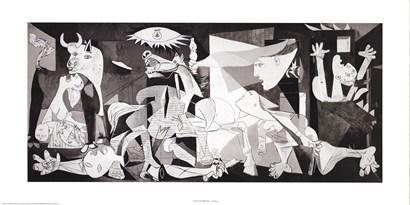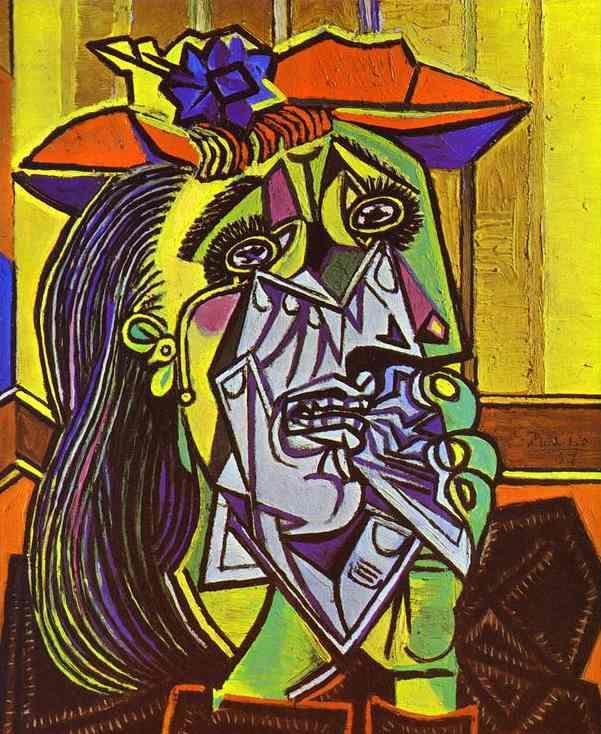Pablo Picasso can be discussed as one of the unique artists of the twentieth century because his works represent different styles and approaches which are correlated with the periods of the artist’s development and his moods. Thus, the talent of Pablo Picasso can be discussed as rather diverse because this person is known not only as a prominent sculptor and a painter but also as a printmaker, a stage designer, a ceramicist, and even as a poet. As a result, Picasso’s works reflect all the changes in the artist’s vision of style and meaning. The most common periods in Picasso’s artistic career include the Blue Period (1901-1904), the Rose Period (1904 – 1906), the African Period (1907-1909), the Analytic Cubism Period (1909 – 1912), and the Synthetic Cubism Period (1912-1919), and the works painted during these periods are extremely different in their forms, styles, and color schemes (Dantini, 2008, p. 102). To understand the variety and importance of Pablo Picasso’s contribution to the world art, it is necessary to focus on analyzing such artist’s famous works as Boy with a Pipe (1905), Guernica (1937), and The Weeping Woman (1937).
The Critique of the Artworks
Throughout his artistic career, Picasso was the highly flexible, dynamic, and versatile artist who was oriented to find new paths about manipulating various styles, forms, and colors (Dantini, 2008, p. 102). From this point, Picasso developed his talent while trying to work within many art styles, and he demonstrated the impressive results while concentrating on different movements and artistic approaches (Walther, 2000, p. 67-68). Boy with a Pipe (1905) is Picasso’s painting which belongs to the Rose Period, and it represents the period’s main features and characteristics. During the period, Picasso focuses on painting many people in pink, orange, in red colors (Walther, 2000, p. 67).
The shapes and forms are depicted close to reality, and the paintings of this period are characterized by the depiction of the real-world objects accentuate with the help of pink colors. The boy from the painting is depicted while holding a pipe and having the wreath of flowers over his head. The boy’s blue clothes and the red background are in contrast, and this contrast helps to emphasize the boy’s features more clearly. It is important to note that during this period, Picasso focuses on using the colors to express his ideas and reflect the inner world and emotions of the depicted persons and the artist (Walther, 2000, p. 67-68). The colors used by Picasso not only add to the work’s aesthetic value but also help to reveal the work’s unique message.

Boy with a Pipe (1905)One of the most famous works painted by Picasso is Guernica (1937), which was painted by the artist as his response to dramatic bombings in Guernica. Thus, the artwork presents the sufferings of many people and animals who became victims of violence. Picasso painted Guernica in grey, black, and white colors to accentuate the dramatic nature of the event. The tones of the grey, blue-grey, and black colors change in their intensity to provide a significant dramatic effect on the audience. The painting is rather symbolic, and all the depicted figures demonstrate their opposition and suffering about the event. The shapes and forms typical for Cubism are chosen to accentuate their interrelations and symbolic meanings. Thus, the viewer can pay attention to the unique shifts from one form to another and from one color to another, and these shifts are used to emphasize the flow of the artist’s thoughts represented on canvas (Serres, 2010, p. 25). It is rather difficult to interpret the meaning of the painting, and the viewers are inclined to discuss possible interpretations with references to the analysis of the presented symbols of the bull and the horse.

Guernica (1937)Guernica is also discussed as one of the most influential works painted by Picasso because it was followed by the series of the other artworks associated with Guernica such as The Weeping Woman (1937). In spite of the fact that The Weeping Woman is painted in vivid colors different from the color used in Guernica, this painting repeats Guernica about the theme. The represented weeping woman seems to suffer because of the tragedy of the war. However, many interpreters are inclined to discuss the image of the weeping woman as symbolizing the idea of suffering in all its meanings. It is important to pay attention to the fact that Picasso changed the color scheme and shapes presented in the painting during many years, and the theme of the weeping woman was also repeated in the artist’s other works (Rubin & Armstrong, 2012, p. 89-92). Furthermore, The Weeping Woman can be discussed as the most typical example of the artist’s approach to Cubism with its emphasis on the unique forms and lines, interrelated symbols, and bright colors. Although the background and dominating colors used in the painting are rather vivid, the central element of the painting is depicted in grey to represent the woman’s grief.

Pablo Picasso’s works can intrigue and surprise the viewer if they are examined in perspective and with focusing on different periods because they differ from each other significantly. However, the artist’s style can be noticed with references to the paintings’ messages which are repeated in many works as the reflections of the artist’s ideas.
Conclusion
Pablo Picasso is among the most reputable artists of the twentieth century whose works attract the audience’s attention during the decades. Today, Picasso is recognized as one of the major contributors to art development in the twentieth century. I can state that the uniqueness of Picasso’s talent is in the artist’s ability to shift from one artistic approach to another without any difficulties. Thus, Picasso’s paintings belonging to the early periods of his work are characterized by the focus on depicting the real objects in their variety.
On the contrary, Picasso’s latest works are influenced by Cubism, and they differ greatly from the previous rather traditional works painted to reflect the artist’s emotions. With this great stylistic versatility, Picasso demonstrates his ability to practice various styles of art in any form. That is why Picasso’s artistic heritage is rather diverse about style. Interestingly, Picasso is persuasive in any followed manner because of the artist’s talent and ability to paint out of his imagination and memory. I can state that I am interested in Picasso’s works because the artist was inclined to depict the objects, persons, and situations which were extremely significant for his life.
References
Dantini, M. (2008). Modern and contemporary art. New York City, NY: Sterling Publishers.
Rubin, W., & Armstrong, M. (2012). The William S. Paley Collection: A Taste for Modernism. USA: The Museum of Modern Art.
Serres, A. (2010). And Picasso painted Guernica. USA: Allen & Unwin.
Walther, I. (2000). Picasso. USA: Taschen.